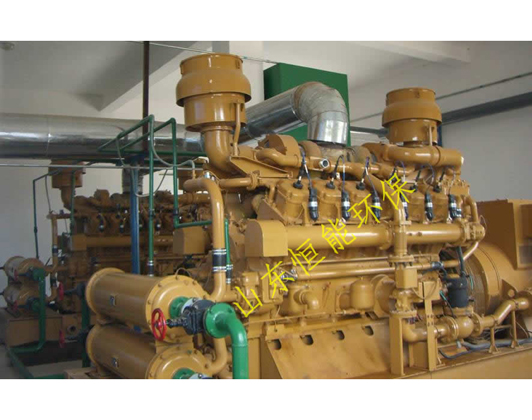歡迎進入山東恒能環(huán)保能源設(shè)備有限公司
歡迎進入山東恒能環(huán)保能源設(shè)備有限公司
干發(fā)脫硫是一種簡易、高效、相對低成本的脫硫方式,一般適合用于沼氣量小,硫化氫濃度低的沼氣脫硫。干法脫除沼氣氣體中硫化氫(H2S)的設(shè)備基本原理是以O(shè)2使H2S氧化成硫或硫氧化物的一種方法,也可稱為干式氧化法。干法設(shè)備的構(gòu)成是,在一個容器內(nèi)放入填料,填料層有活性炭、氧化鐵等。氣體以低流速從一端經(jīng)過容器內(nèi)填料層,硫化氫(H2S)氧化成硫或硫氧化物后,余留在填料層中,凈化后氣體從容器另一端排出。干式脫硫主要包括主體鋼結(jié)構(gòu)、脫硫劑填料、觀察窗、壓力表、溫度表等組件。
Dry flue gas desulfurization is a simple, efficient, and relatively low-cost desulfurization method, generally suitable for biogas desulfurization with small biogas volume and low hydrogen sulfide concentration. The basic principle of the equipment for dry removal of hydrogen sulfide (H2S) from biogas gas is a method of using O2 to oxidize H2S into sulfur or sulfur oxides, also known as dry oxidation method. The composition of dry process equipment is to place fillers in a container, and the filler layer includes activated carbon, iron oxide, etc. The gas passes through the packing layer inside the container at a low flow rate, and hydrogen sulfide (H2S) is oxidized to sulfur or sulfur oxides, remaining in the packing layer. After purification, the gas is discharged from the other end of the container. Dry desulfurization mainly includes components such as main steel structure, desulfurizer filler, observation window, pressure gauge, temperature gauge, etc.
脫硫塔通常設(shè)計為一用一備,交替使用,即一個脫硫,一個再生。含有硫化氫(H2S)的沼氣進入脫硫塔底部,在穿過脫硫填料層到達頂端的過程中,H2S與脫硫劑發(fā)生以下的化學(xué)反應(yīng):第一步:Fe2O3·H2O+3H2S=Fe2S3+4H2O(脫硫)第二步:Fe2S3+3/2O2+3H2O=Fe2O3·H2O+2H2O+3S(再生)含有硫化氫的沼氣首先與底部入口處荷載相對高的脫硫劑反應(yīng),反應(yīng)器上部是負(fù)載低的脫硫劑層,通過設(shè)計良好的沼氣空速和線速,干式脫硫能到達良好的精脫硫效果。在沼氣進入干式脫硫塔之前,應(yīng)設(shè)置有冷凝水罐或沼氣顆粒過濾器。該裝置可以消除沼氣中夾雜的顆粒雜志,并使得沼氣在進入脫硫前含有一定濕度。當(dāng)觀察到脫硫劑變色,或系統(tǒng)壓力損失過大時,應(yīng)交替使用另一個脫硫塔。當(dāng)前的脫硫塔在沼氣放空后,進行自然通風(fēng),對脫硫劑進行再生。當(dāng)再生效果不佳時,應(yīng)從塔體底部將廢棄的脫硫劑排除,在底部排放廢棄填料的同時,相同體積的新鮮脫硫填料加入反應(yīng)器中。濕法脫硫可以歸納分為物理吸收法、化學(xué)吸收法和氧化法三種。

Desulfurization towers are usually designed as one for use and one for backup, alternating between one for desulfurization and one for regeneration. Biogas containing hydrogen sulfide (H2S) enters the bottom of the desulfurization tower. During the process of passing through the desulfurization filler layer and reaching the top, H2S undergoes the following chemical reaction with the desulfurizer: Step 1: Fe2O3 · H2O+3H2S=Fe2S3+4H2O (desulfurization) Step 2: Fe2S3+3/2O2+3H2O=Fe2O3 · H2O+2H2O+3S (regeneration) Biogas containing hydrogen sulfide first reacts with the desulfurizer with a relatively high load at the bottom inlet. The upper part of the reactor is a low load desulfurizer layer. Through well-designed biogas airspeed and linear velocity, dry desulfurization can achieve good precision desulfurization effect. Before biogas enters the dry desulfurization tower, a condensate tank or biogas particle filter should be installed. This device can eliminate particle magazines mixed in biogas and make biogas contain a certain humidity before entering desulfurization. When discoloration of the desulfurizer or excessive pressure loss in the system is observed, another desulfurization tower should be used alternately. The current desulfurization tower undergoes natural ventilation after releasing biogas to regenerate the desulfurizer. When the regeneration effect is poor, the waste desulfurizer should be discharged from the bottom of the tower. At the same time as the waste packing is discharged at the bottom, fresh desulfurized packing of the same volume should be added to the reactor. Wet desulfurization can be classified into three types: physical absorption method, chemical absorption method, and oxidation method.
物理和化學(xué)方法存在硫化氫再處理問題,氧化法是以堿性溶液為吸收劑,并加入載氧體為催化劑,吸收H2S,并將其氧化成單質(zhì)硫,濕法氧化法是把脫硫劑溶解在水中,液體進入設(shè)備,與沼氣混合,沼氣中的硫化氫(H2S)與液體產(chǎn)生氧化反應(yīng),生成單質(zhì)硫吸收硫化氫的液體有氫氧化鈉、氫氧化鈣、碳酸鈉、硫酸亞鐵等。成熟的氧化脫硫法,脫硫效率可達99.5%以上。在大型的脫硫工程中,一般采用先用濕法進行粗脫硫,之后再通過干法進行精脫硫。濕法脫硫塔主體包括洗滌塔、硫化氫采樣與監(jiān)測系統(tǒng)、堿液配置槽、供水軟水裝置、液位控制系統(tǒng)、支撐件和連接件。
There is a problem of hydrogen sulfide reprocessing in physical and chemical methods. The oxidation method uses an alkaline solution as an absorbent and an oxygen carrier as a catalyst to absorb H2S and oxidize it into elemental sulfur. The wet oxidation method dissolves the desulfurizer in water, and the liquid enters the equipment and mixes with biogas. Hydrogen sulfide (H2S) in biogas reacts with the liquid to form elemental sulfur. The liquids that absorb hydrogen sulfide include sodium hydroxide, calcium hydroxide, sodium carbonate, ferrous sulfate, etc. The mature oxidation desulfurization method can achieve a desulfurization efficiency of over 99.5%. In large-scale desulfurization projects, wet desulfurization is generally used first for coarse desulfurization, and then dry desulfurization is used for fine desulfurization. The main body of the wet flue gas desulfurization tower includes a washing tower, a hydrogen sulfide sampling and monitoring system, an alkali solution preparation tank, a water supply softening device, a liquid level control system, supporting components, and connecting components.
脫硫系統(tǒng)通過對出氣硫化氫濃度的監(jiān)控以及PH值監(jiān)控,實現(xiàn)全自動運行。運行時,沼氣由下至上通過脫硫塔,Na2CO3溶液(或NaOH溶液)從頂部向下噴淋,使得H2S氣體與堿液發(fā)生了充分的化學(xué)反應(yīng)。堿液存儲在脫硫塔的下方,通過計量泵自動添加,計量泵的添加控制通過對出氣H2S濃度的監(jiān)控自動運行。當(dāng)采用碳酸鈉(Na2CO3)試劑脫硫時,主要發(fā)生如下反應(yīng):H2S+Na2CO3=NaHS+NaHCO3(1)CO2+Na2CO3+H2O=2NaHCO3(2)由于沼氣中含有的大量CO2成分,同樣會消耗堿液。
The desulfurization system achieves fully automatic operation by monitoring the concentration of hydrogen sulfide in the outlet gas and pH value. During operation, biogas passes through the desulfurization tower from bottom to top, and Na2CO3 solution (or NaOH solution) is sprayed downwards from the top, causing sufficient chemical reaction between H2S gas and alkaline solution. Alkali solution is stored below the desulfurization tower and automatically added through a metering pump. The addition control of the metering pump operates automatically by monitoring the H2S concentration in the outlet gas. When using sodium carbonate (Na2CO3) reagent for desulfurization, the following reactions mainly occur: H2S+Na2CO3=NaHS+NaHCO3 (1) CO2+Na2CO3+H2O=2NaHCO3 (2) Due to the large amount of CO2 content in biogas, alkaline solution is also consumed.
系統(tǒng)應(yīng)能對反應(yīng)條件(包括反應(yīng)溫度、PH值)等進行控制,設(shè)置最優(yōu)反應(yīng)條件,盡可能地減少堿液的消耗量。生物脫硫技術(shù)包括生物過濾法、生物吸附法和生物滴濾法,三種系統(tǒng)均屬開放系統(tǒng),其微生物種群隨環(huán)境改變而變化。在生物脫硫過程中,氧化態(tài)的含硫污染物必須先經(jīng)生物還原作用生成硫化物或H2S然后再經(jīng)生物氧化過程生成單質(zhì)硫,才能去除。在大多數(shù)生物反應(yīng)器中,微生物種類以細(xì)菌為主,真菌為次,極少有酵母菌。常用的細(xì)菌是硫桿菌屬的氧化亞鐵硫桿菌,脫氮硫桿菌及排硫桿菌。最成功的代表是氧化亞鐵硫桿菌,其生長的最佳pH值為2.0~2.2。
The system should be able to control the reaction conditions (including reaction temperature, pH value), set the optimal reaction conditions, and minimize the consumption of alkaline solution as much as possible. Biological desulfurization technology includes biological filtration, biological adsorption, and biological drip filtration, all of which belong to open systems, and their microbial populations change with environmental changes. In the process of biological desulfurization, oxidized sulfur-containing pollutants must first undergo biological reduction to generate sulfides or H2S, and then undergo biological oxidation to generate elemental sulfur in order to be removed. In most bioreactors, the microbial species are mainly bacteria, followed by fungi, and there are very few yeast. The commonly used bacteria are Thiobacillus ferrooxidans, Thiobacillus denitrifying, and Thiobacillus excreting. The most successful representative is Thiobacillus ferrooxidans, with an optimal pH value of 2.0-2.2 for its growth.
本文由沼氣脫硫提供技術(shù)支持,更多的詳細(xì)精彩內(nèi)容請點擊我們的網(wǎng)站 http://usacato.cn,我們將會全心全意為您提供滿意的服務(wù)。
This article provides technical support for biogas desulfurization. For more detailed and exciting content, please click on our website http://usacato.cn We will wholeheartedly provide you with satisfactory service.